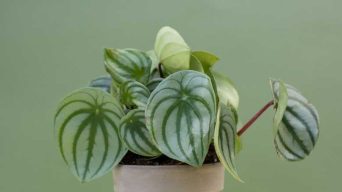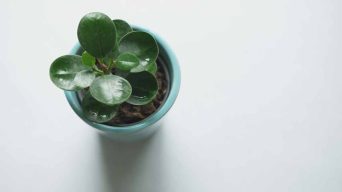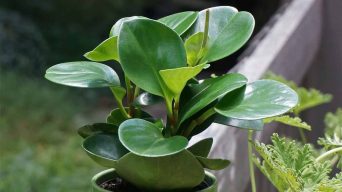Key Takeaways
- Peperomia plants like to be slightly root-bound, but it’s important not to let their roots become too overcrowded, as this may cause harm to their overall health.
- Being root-bound can negatively affect Peperomia plants, compromising the plant’s physical state and increasing susceptibility to diseases such as root rot caused by overwatering.
- Repotting Peperomia plants is vital to promote healthy growth, but it should be done in moderation. Use a well-draining soil mix, choose a pot one size bigger than the current pot, and water sparingly at first after repotting them.
As a plant enthusiast, you want nothing but the best for your beloved peperomias.
One question that often arises among houseplant owners is, “Do peperomia like to be root bound?”
This blog post will provide all the essential information on this topic, discussing the effect of being root-bound on these popular indoor plants and how it influences their growth and overall health.
Understanding Root-Bound Plants
To determine if Peperomia plants prefer being root-bound, it is essential to understand the concept of root-bound plants and the potential risks involved.
When a plant’s roots have fully occupied the pot, leaving no space for further growth, it is considered root-bound.
What Does It Mean To Be Root-bound?
Root-bound refers to a situation where a plant’s roots have outgrown their container, resulting in crowding and tangled growth.
This congested environment restricts the roots from proper access to nutrients, water, and air necessary for healthy development.
For example, imagine wearing shoes that are too small for your feet; this would ultimately lead to discomfort and hinder movement.
In severe cases of being root-bound, you may even notice that thick masses of entwined roots have replaced the soil with little room left for anything else.
This limits nutrient absorption and makes watering increasingly difficult as water runs off rather than penetrating the solid mass of roots.
Causes Of Root-bound Plants
Root-bound plants often result from extended periods spent in containers that are too small for their growing needs.
As the plant’s roots expand and search for moisture, nutrients, and room to grow, they become entangled, forming a tight mass that limits overall growth.
Environmental factors such as inadequate watering schedules can exacerbate root-binding issues.
Plants receiving insufficient water will sometimes develop deeper or more extensive root systems to reach any available moisture sources.
Unfortunately, this process can lead directly into a situation where roots have nowhere to grow other than back upon themselves.
Overly rich potting soil mixes with poor drainage may also encourage rapid root development without providing enough space or structure for expansion.
Risks Of Leaving Plants Root-bound
Leaving plants root-bound for an extended period can pose several risks to their health and overall growth.
One primary concern is that a pot-bound plant will struggle to access essential nutrients, air, and water because its roots have replaced most of the soil in the container.
Furthermore, when a plant’s roots are crammed into tight spaces without room to grow, they often begin circling the inside of the pot, known as girdling.
Girdled roots grow entangled with one another and can eventually choke off their food and water supply from other areas within the root system.
In severe cases, you may notice visible roots above the soil surface – a telltale sign your plant desperately needs repotting.
Do Peperomia Plants Like To Be Root Bound?
Peperomia plants thrive when their roots are slightly cramped.
Since they have shallow roots and do well in small containers, repotting is only required once the plant has grown considerably.
Characteristics Of Peperomia Plants
Peperomia plants are popular among plant enthusiasts thanks to their unique appearance and ease of care.
These plants have thick, succulent-like leaves that come in various shapes and colors, ranging from bright green to shades of red, silver, and even black.
Peperomia plants are relatively small and can grow up to 10 inches tall.
One significant characteristic of peperomia plants is that they have shallow root systems that spread horizontally rather than vertically.
This helps them survive in relatively small pots for extended periods without repotting as often as other houseplants might require.
Effects Of Being Root-bound On Peperomia Plants
Being root-bound can have adverse effects on Peperomia plants.
This condition occurs when the plant’s roots outgrow their container and become tangled and compacted, depriving them of space to expand.
In addition to compromising the plant’s physical state, being root-bound increases its susceptibility to diseases such as root rot caused by overwatering.
However, a slightly root-bound condition can benefit peperomia plants since it encourages the development of new roots while preventing excessive water retention.
Proper Care For Root-Bound Peperomia Plants
If you want your peperomia plant to grow well and avoid root damage, it’s important to repot it when the roots start peeking through the drainage holes.
Read on to discover the best soil mixes and potting techniques for these commonly grown indoor plants.
Signs It’s Time To Repot Your Peperomia
If you want to keep your Peperomia plants healthy and thriving, knowing when it’s time to repot them is important.
Here are some signs that indicate it’s time to give your Peperomia a new pot:
- Roots peeking out of the drainage holes – If you notice roots growing out of the bottom of the current pot or peeking out through the drainage holes, it indicates that your plant has outgrown its current container.
- Yellowing leaves – Yellowing leaves on your Peperomia plant can be a sign of root rot, which occurs when there is insufficient space for water and air to circulate in the soil. Repotting with fresh soil will help solve this problem.
- Slow growth – If you notice that your Peperomia plant has stopped growing or has slowed down significantly, it may be because it has run out of space in its current pot.
- Root-bound appearance – A root-bound appearance is when roots have taken up most of the space in their current pot, leaving no room for further growth. This can cause the plant to appear tightly packed or even push itself up and out of its container.
- Wilting – If your Peperomia is wilting despite adequate watering, it could be due to insufficient nutrients or space in its current pot.
Remember that Peperomias do like being slightly root-bound but don’t let their roots become too overcrowded, as this may cause harm to their overall health.
Potting And Repotting Techniques For Peperomia Plants
Repotting Peperomia plants is vital to promote healthy growth, but it should be done in moderation.
Below are some potting and repotting techniques to keep your Peperomia plant thriving:
1. Signs it’s time to repot your Peperomia
- Check for an abundance of roots taking up all the space in the current pot.
- Look for wilted leaves, stunted growth, or yellowing leaves.
2. Potting Soil Mixes for Peperomia Plants
- Use a well-draining soil mix, such as perlite, peat moss, or coco coir.
- Add some compost to the mix to provide essential nutrients.
3. Repotting Techniques for Peperomia Plants
- Choose a pot that is one size bigger than the current pot.
- Gently loosen the roots from the root ball and remove any dead or damaged roots.
- Place fresh soil mix on the bottom of the new pot and position the plant in the center.
- Fill with fresh soil until it reaches 1 inch below the pot’s rim.
4. Watering and Fertilizing Techniques for Peperomia Plants
- Water your newly repotted plant sparingly, ensuring you don’t overwater it.
- Feed with a balanced fertilizer once every two weeks during the growing season (summer months).
5. Pruning and Maintenance Tips for Peperomia Plants
- Regularly prune your peperomias to encourage bushy growth.
- Mist regularly with water to create a high humidity environment around your plant.
Best Soil Mixes For Peperomia Plants
Choosing the right soil mix is crucial for the health and growth of your Peperomia plants.
Here are some of the best soil mixes for Peperomia plants:
- Succulent or Cactus Mix: Peperomias have succulent characteristics, so a well-draining soil mix that supports this feature is ideal. A succulent or cactus mix works well because it provides good drainage and prevents overwatering.
- Perlite Mix: A perlite mix is another great option for Peperomias as it helps to aerate the soil and improve drainage. It also helps to prevent waterlogging, which can cause root rot.
- Vermiculite Mix: Vermiculite is a natural mineral with excellent water retention properties while providing good drainage. It also helps to increase moisture in the soil, which is beneficial for Peperomias, which thrive in high humidity environments.
- Coir Mix: Coir is made from coconut fibers and provides a lightweight, well-draining soil mix that holds moisture well. It’s an eco-friendly option and ensures good airflow around the roots of your plants.
- Peat Moss Mix: Peat moss provides excellent moisture retention properties while allowing for good airflow around the roots of your plants. However, it’s essential not to use too much peat moss as it can lead to compacted soils and drainage issues.
Remember to choose a soil mix based on your specific type of Peperomia plant and its needs.
Watering And Fertilizing Techniques For Peperomia Plants
Peperomia plants are known for their easy care, which extends to their watering and fertilizing needs.
Here are some techniques to ensure your peperomia plants stay healthy:
- Watering: Peperomia plants like to have moist soil but do not like standing in water. Allow the top layer of soil to dry out before watering again, usually every one to two weeks, depending on the humidity level of your environment. Bottom watering is a recommended method for watering peperomia plants as it prevents overwatering and waterlogging the roots.
- Fertilizing: Peperomia plants have slow growth and tiny root systems, so avoid over-fertilization, which can harm them. Feed them with a balanced liquid fertilizer diluted to half strength during the growing season, which lasts from spring through summer; once a month should be enough.
- Maintenance: Removing wilted or yellowed leaves regularly is important, as they can become a breeding ground for pests or diseases if left unattended.
Pruning And Maintenance Tips For Peperomia Plants
Peperomia plants are known for their hardy nature, making them an excellent choice for plant owners just starting.
However, it is still important to properly care for and prune these plants to ensure their growth and health.
Here are some tips for pruning and maintaining your Peperomia plant:
- Pinch back the stems: Use a cutting tool or your fingers to encourage bushiness in your Peperomia plant. This will help maximize its growth and give it a fuller appearance.
- Remove any yellow or damaged leaves: Yellow or damaged leaves can signal a plant health problem. To prevent further damage, gently remove any affected leaves immediately.
- Lightly prune in early spring: In early spring, lightly prune your Peperomia plant to correct any sparse or leggy growth from the previous season.
- Maintain proper watering habits: It is important to water your Peperomia plant every 1-2 weeks, allowing the potting soil to dry out between waterings. Avoid overwatering, which can lead to root rot and other diseases.
- Ensure good drainage: Good drainage is essential for healthy Peperomia plants. Ensure your pot has adequate drainage holes and that excess water can easily escape.
- Fertilize sparingly: Peperomias do not require frequent fertilization but benefit from occasional nutrient boosts during their growing season (spring through summer). Use a balanced fertilizer and follow the instructions carefully.
Final Thoughts
Peperomia plants generally do not like being root-bound but can thrive a little in this state.
These plants have a shallow root system and perform well in small containers.
Repotting is only necessary when the roots are visible through the drainage holes, and caution should be exercised not to overwater them during this process.







